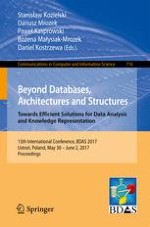2017 | Buch
Beyond Databases, Architectures and Structures. Towards Efficient Solutions for Data Analysis and Knowledge Representation
13th International Conference, BDAS 2017, Ustroń, Poland, May 30 - June 2, 2017, Proceedings
herausgegeben von: Stanisław Kozielski, Dariusz Mrozek, Paweł Kasprowski, Bożena Małysiak-Mrozek, Daniel Kostrzewa
Verlag: Springer International Publishing
Buchreihe : Communications in Computer and Information Science
